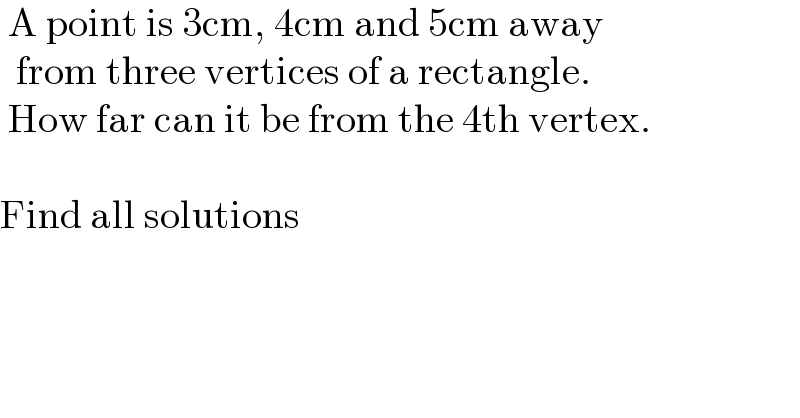
Question Number 170202 by otchereabdullai@gmail.com last updated on 18/May/22

$$\:\mathrm{A}\:\mathrm{point}\:\mathrm{is}\:\mathrm{3cm},\:\mathrm{4cm}\:\mathrm{and}\:\mathrm{5cm}\:\mathrm{away}\: \\ $$$$\:\:\mathrm{from}\:\mathrm{three}\:\mathrm{vertices}\:\mathrm{of}\:\mathrm{a}\:\mathrm{rectangle}.\: \\ $$$$\:\mathrm{How}\:\mathrm{far}\:\mathrm{can}\:\mathrm{it}\:\mathrm{be}\:\mathrm{from}\:\mathrm{the}\:\mathrm{4th}\:\mathrm{vertex}. \\ $$$$ \\ $$$$\mathrm{Find}\:\mathrm{all}\:\mathrm{solutions} \\ $$
Commented by otchereabdullai@gmail.com last updated on 18/May/22

$$\mathrm{much}\:\mathrm{much}\:\mathrm{grateful}\:\mathrm{thanks} \\ $$
Commented by mr W last updated on 18/May/22

$${there}\:{are}\:{infinitely}\:{many}\:{solutions}. \\ $$
Commented by MJS_new last updated on 18/May/22

$$\mathrm{it}'\mathrm{s}\:\mathrm{either}\:\mathrm{0}\vee\mathrm{3}\sqrt{\mathrm{2}}\vee\mathrm{4}\sqrt{\mathrm{2}} \\ $$
Commented by otchereabdullai@gmail.com last updated on 18/May/22

$$\mathrm{please}\:\mathrm{help}\:\mathrm{me}\:\mathrm{with}\:\mathrm{some}\:\mathrm{of}\:\mathrm{the}\: \\ $$$$\mathrm{solutions}\:\mathrm{prof}\:\mathrm{W} \\ $$
Commented by otchereabdullai@gmail.com last updated on 18/May/22

$$\mathrm{prof}\:\mathrm{mjs}\:\mathrm{how}\:\mathrm{did}\:\mathrm{you}\:\mathrm{get}\:\mathrm{the}\: \\ $$$$\mathrm{0}\vee\mathrm{3}\sqrt{\mathrm{2}}\vee\mathrm{4}\sqrt{\mathrm{2}} \\ $$
Commented by MJS_new last updated on 18/May/22

$$``\mathrm{fix}''\:\mathrm{the}\:\mathrm{vertices} \\ $$$${A}=\begin{pmatrix}{\mathrm{0}}\\{\mathrm{0}}\end{pmatrix}\:\:\:\:\:{B}=\begin{pmatrix}{{a}}\\{\mathrm{0}}\end{pmatrix}\:\:\:\:\:{C}=\begin{pmatrix}{{a}}\\{{b}}\end{pmatrix}\:\:\:\:\:{D}=\begin{pmatrix}{\mathrm{0}}\\{{b}}\end{pmatrix} \\ $$$$\mathrm{let}\:{P}=\begin{pmatrix}{{p}}\\{{q}}\end{pmatrix} \\ $$$$\mathrm{equations}\:\mathrm{with}\:\alpha,\:\beta,\:\gamma\:\mathrm{unknown}\:\mathrm{at}\:\mathrm{first} \\ $$$$\left(\mathrm{1}\right)\:\:\:\:\:\mid{AP}\mid^{\mathrm{2}} =\alpha^{\mathrm{2}} \\ $$$$\left(\mathrm{2}\right)\:\:\:\:\:\mid{BP}\mid^{\mathrm{2}} =\beta^{\mathrm{2}} \\ $$$$\left(\mathrm{3}\right)\:\:\:\:\:\mid{CP}\mid^{\mathrm{2}} =\gamma^{\mathrm{2}} \\ $$$$\left(\mathrm{4}\right)\:\:\:\:\:\mid{DP}\mid^{\mathrm{2}} ={x}^{\mathrm{2}} \\ $$$$\mathrm{you}\:\mathrm{can}\:\mathrm{easily}\:\mathrm{solve}\:\mathrm{the}\:\mathrm{system}\:\mathrm{for}\:{p},\:{q}\:\mathrm{and} \\ $$$$\mathrm{get}\:\mathrm{a}\:\mathrm{formula}\:\mathrm{for}\:{x}^{\mathrm{2}} .\:\mathrm{now}\:\mathrm{insert}\:\mathrm{all}\:\mathrm{possible} \\ $$$$\mathrm{permutations}\:\mathrm{of}\:\mathrm{3},\:\mathrm{4},\:\mathrm{5}\:\mathrm{for}\:\alpha,\:\beta,\:\gamma \\ $$
Commented by mr W last updated on 18/May/22

$${you}\:{are}\:{right}\:{sir}! \\ $$$${though}\:{there}\:{are}\:{infinitely}\:{many}\:{such} \\ $$$${rectangles},\:{but}\:{the}\:{distance}\:{to}\:{the} \\ $$$${fourth}\:{vertex}\:{is}\:{constant}. \\ $$$${x}=\sqrt{\alpha^{\mathrm{2}} +\beta^{\mathrm{2}} −\gamma^{\mathrm{2}} } \\ $$$${x}=\sqrt{\mathrm{3}^{\mathrm{2}} +\mathrm{4}^{\mathrm{2}} −\mathrm{5}^{\mathrm{2}} }=\mathrm{0} \\ $$$${x}=\sqrt{\mathrm{3}^{\mathrm{2}} +\mathrm{5}^{\mathrm{2}} −\mathrm{4}^{\mathrm{2}} }=\mathrm{3}\sqrt{\mathrm{2}} \\ $$$${x}=\sqrt{\mathrm{4}^{\mathrm{2}} +\mathrm{5}^{\mathrm{2}} −\mathrm{3}^{\mathrm{2}} }=\mathrm{4}\sqrt{\mathrm{2}} \\ $$
Commented by mr W last updated on 18/May/22

Commented by mr W last updated on 18/May/22

$$\alpha^{\mathrm{2}} ={a}_{\mathrm{1}} ^{\mathrm{2}} +{b}_{\mathrm{2}} ^{\mathrm{2}} \\ $$$$\beta^{\mathrm{2}} ={a}_{\mathrm{2}} ^{\mathrm{2}} +{b}_{\mathrm{1}} ^{\mathrm{2}} \\ $$$$\Rightarrow\alpha^{\mathrm{2}} +\beta^{\mathrm{2}} ={a}_{\mathrm{1}} ^{\mathrm{2}} +{a}_{\mathrm{2}} ^{\mathrm{2}} +{b}_{\mathrm{1}} ^{\mathrm{2}} +{b}_{\mathrm{2}} ^{\mathrm{2}} \\ $$$${x}^{\mathrm{2}} ={a}_{\mathrm{2}} ^{\mathrm{2}} +{b}_{\mathrm{2}} ^{\mathrm{2}} \\ $$$$\gamma^{\mathrm{2}} ={a}_{\mathrm{1}} ^{\mathrm{2}} +{b}_{\mathrm{1}} ^{\mathrm{2}} \\ $$$$\Rightarrow{x}^{\mathrm{2}} +\gamma^{\mathrm{2}} ={a}_{\mathrm{1}} ^{\mathrm{2}} +{a}_{\mathrm{2}} ^{\mathrm{2}} +{b}_{\mathrm{1}} ^{\mathrm{2}} +{b}_{\mathrm{2}} ^{\mathrm{2}} \\ $$$$\Rightarrow\boldsymbol{{x}}^{\mathrm{2}} +\boldsymbol{\gamma}^{\mathrm{2}} =\boldsymbol{\alpha}^{\mathrm{2}} +\boldsymbol{\beta}^{\mathrm{2}} \\ $$
Commented by Tawa11 last updated on 08/Oct/22

$$\mathrm{Great}\:\mathrm{sirs} \\ $$
